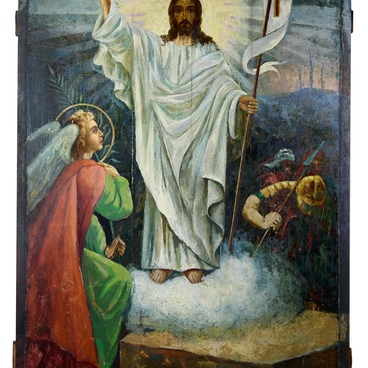It was centuries before the specific features of Christian temple architecture took shape. The interior design of churches underwent changes at different historical stages. It is believed that the need to separate the altar area with an iconostasis and the Royal Doors arose when the number of parishioners started to increase. A certain protective barrier had to be set up to prevent the unpredictable influx of believers from entering the holy place.
Originally such protection was provided by special pillars. These were placed around the altar, and the space between them was enclosed by bronze partitions. The central aisle was open and a passageway to the altar was provided through it. An example of such a design of church interior can be found, for example, in the Church of the Holy Sepulcher. Another way of protecting the altar space was a special veil, the Katapetasma, which can still be found in many churches today.
The Royal Doors are hinged doors traditionally located opposite the Holy Table (in the altar — the main part of the church). They are the main doors of the iconostasis in churches belonging to the Orthodox Christian branch. The Royal Doors are symbolic of the Doors of Paradise. As a rule, in the Orthodox tradition the four Evangelists are depicted on the doors, heralding the joyful news of the incarnation of Christ, opening the Doors of salvation, as well as the Annunciation scene indicating that the Doors of Paradise, closed after the fall of man, are open for people again. All this is shown on the displayed right door of the Royal Doors.
At the top is an icon of Mark the Evangelist. The middle section features an image of the Virgin Mary. At the bottom is an image of John the Evangelist. In the middle of the overall composition is an icon of the Mother of God, an element of the Annunciation scene. These Royal Doors were part of the iconostasis of the Church of the Icon of the Mother of God “Joy of All Who Sorrow” of the city of Michurinsk from the 1940s until the early 21st century.
Originally such protection was provided by special pillars. These were placed around the altar, and the space between them was enclosed by bronze partitions. The central aisle was open and a passageway to the altar was provided through it. An example of such a design of church interior can be found, for example, in the Church of the Holy Sepulcher. Another way of protecting the altar space was a special veil, the Katapetasma, which can still be found in many churches today.
The Royal Doors are hinged doors traditionally located opposite the Holy Table (in the altar — the main part of the church). They are the main doors of the iconostasis in churches belonging to the Orthodox Christian branch. The Royal Doors are symbolic of the Doors of Paradise. As a rule, in the Orthodox tradition the four Evangelists are depicted on the doors, heralding the joyful news of the incarnation of Christ, opening the Doors of salvation, as well as the Annunciation scene indicating that the Doors of Paradise, closed after the fall of man, are open for people again. All this is shown on the displayed right door of the Royal Doors.
At the top is an icon of Mark the Evangelist. The middle section features an image of the Virgin Mary. At the bottom is an image of John the Evangelist. In the middle of the overall composition is an icon of the Mother of God, an element of the Annunciation scene. These Royal Doors were part of the iconostasis of the Church of the Icon of the Mother of God “Joy of All Who Sorrow” of the city of Michurinsk from the 1940s until the early 21st century.


